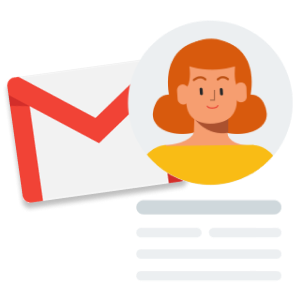As a marketer, email is one of the most powerful tools in your toolkit.
Not only is it a way to build a relationship with your customers over time…
An email list is an asset you own that no social media platform can take away from you.
In this article, we’ll delve into the different types of emails, exploring how many types of emails exist and the various email formats.
Why should you send different types of emails?
Sending nothing but promotional emails to your list is a surefire way to churn and burn your email subscribers.
Think about it…
When you get nothing of value from emails except the sender constantly sending nothing but ‘buy my stuff,’ it’s not long before you hit unsubscribe. And that’s why you should be sending different types of emails.
In this guide, I’m going to walk you through the 7 types of emails you should be sending so you can boost engagement and build strong relationships with your customers.
Here are the 7 types of emails you to send your customers
Here are the best types of emails:
- Newsletter emails
- Nurture emails
- Promotional emails
- Transactional emails
- Milestone emails
- Customer feedback emails
- Price and policy update emails
1. Newsletter emails
As I mentioned at the start of this post, bombarding customers with endless promotions is a good way to churn and burn through your email subscribers. That’s why smart marketers send regular email newsletters so they can keep customers in the loop with industry trends, share what’s new, and stay top of mind.
Let’s take a look at this example from Mockuuups Studio and what makes it so good.
Mockuuups Studio’s monthly newsletter example
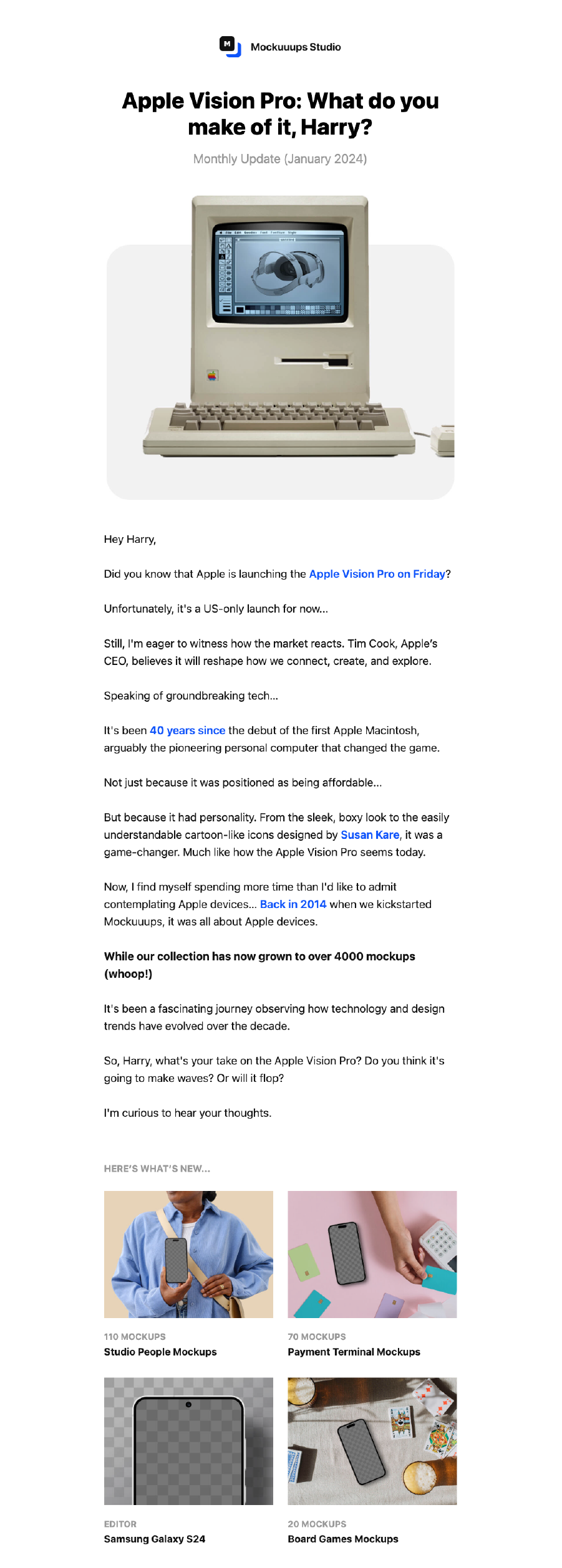
In this email newsletter, you’ll notice how they use both a main text-based section paired with interesting content updates at the end of the email.
It’s the text section up top I want you to pay attention to.
Rather than a newspaper style with a grid of images and updates…
These guys lead in with an editorial section that is written directly from the founder to the recipient using ‘you’ language and email personalization to address you by name.
This section makes the reader feel they’re getting an email directly from the founder each month sharing design industry news and product updates which in the long run builds a strong relationship with the brand.
The takeaway?
Write your email newsletters from someone in the company, it makes it feel like a human-to-human connection, and use email personalization to call out your reader.
2. Nurture emails
Nurture emails are automated emails that get sent out at different stages of the customer journey based on different customer interactions.
Actions like:
- Abandoning a shopping cart and getting a sequence of emails to win them back.
- Encouraging monthly subscription customers to upgrade their plan after an amount of time.
- Or a sequence of drip-sent emails after signing up.
These emails are important because as customers move through your marketing funnel you’ll want to nurture them along their journey so they don’t fall through the cracks.
Nurture emails can include:
- Drip campaigns
- Re-engagement emails
- Abandon cart emails
- Welcome email sequences
Let’s walk you through an abandoned cart email example from Soulsome Chocolate.
Soulsome Chocolate’s abandon cart email example
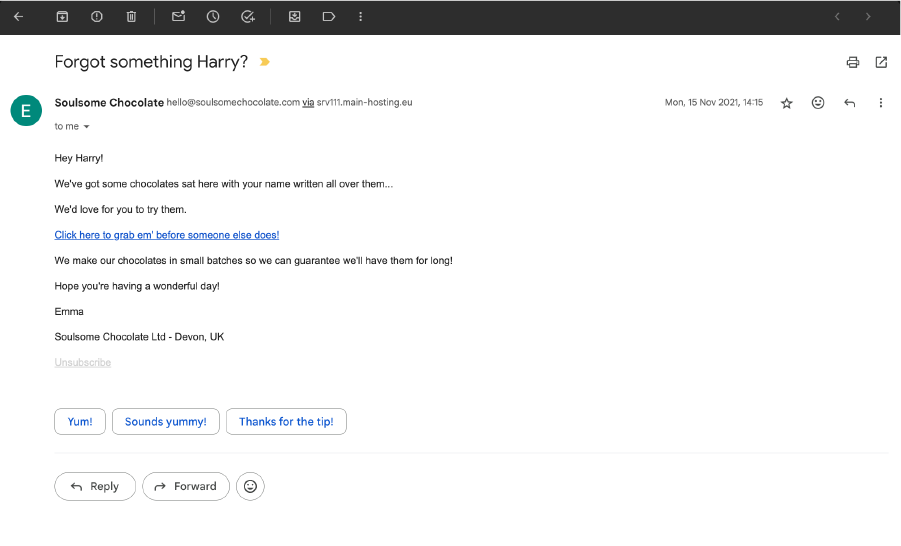
This example from Soulsome Chocolate is sent 15 minutes after abandoning the shopping cart.
You’ll notice how they address the recipient by name and have a bit of fun with the format and paint a picture in your mind of how they’re ready to send these out for you; all you need to do is take the next step. This is an excellent way to re-engage potential customers.
The takeaway?
When writing your nurture emails, add personality and position your emails as if you’re writing to a friend.
3. Promotional emails
Most promotional emails look the same.
Bombarding you with ‘buy my stuff’ emails that soon make you run for the unsubscribe button.
The trick with promotional emails is to a) not look like all the other promotions inside your inbox and b) use a mix of copywriting techniques to make your promotions more effective.
In the following example from Brain.fm, I walk you through techniques you can bring across to your campaigns.
But here are some ways you can make your promotions more successful:
- Write your promotions using words like ‘you’ to make feel you’re talking directly to your recipient.
- Tell a story about the product and how the promotion came to be to communicate the ‘why’ you need to take action now.
- Instead of throwing out discounts use techniques like scarcity and exclusivity to make your offers more appealing.
- Stick to one offer and one clear call to action per email, adding more weakens your message.
- Remember you don’t have to sell someone on the product in your email that’s what your landing page is for, all you need to do is build enough curiosity to click through.
- Avoid common spam trigger words like ‘sale’ and ‘discount’ from landing in your recipient’s inbox.
- Optimize your subject line and email preview to get more opens.
- Segment your customers so you can send different groups and different offers
Brain.FM’s promotional email example

This promotional email from Brain.fm is sent on the last day of your free trial to convert you to a paid customer.
There are a few things I like about this email…
- The subject line ‘You deserve more than just average!” positions the offer as an investment in yourself.
- They communicate their differentiated value in the email explaining how their music is patented to make you focus and include results.
- They add a face to the brand by showing you who makes the music so you know they’re not a huge entity.
How would I improve it?
I’d consider bringing the text up top and making the email from the founder or someone inside the company. Leading with a 25% off headline for me gets my I’m being sold to radar pinging.
The takeaway?
Use techniques other than discounts to sell and increase your perceived value.
4. Transactional emails
When a customer books, purchases, or submits from you, the expectation is they’ll get regular updates about your product or service.
In the book Alchemy by Rory Sutherland (Advertising Exec for Ogilvy), Rory talks about how humans feel better when they know when something is going to happen. I’m sure you prefer it when you get an estimated delivery timeslot over ‘It’ll be with you in the next few days.’
So to ensure people have a good experience with your brand, it’s a good idea to have a mix of these automated transactional emails:
- Confirmation emails
- Shipping notifications
- Payment confirmation emails
Let’s look at a good confirmation email example and what makes it work…
Yallah Coffee’s confirmation email example

In this email confirmation example from Yallah Coffee, you’ll notice a few things:
- They tell you what happens next and the method of shipment to set your expectations.
- They take it a step further by explaining what’s happening behind the scenes to bolster the step with value: “We roast 5 days a week and never send coffee more than 5 days past the roast date.”
The takeaway?
Transactional emails shouldn’t just be bland confirmations. Use them as a touch point to build relationships and communicate what makes you unique.
5. Milestone emails
The biggest challenge with a subscription business is delivering continued value so people stick around.
But before that can happen, customers need to engage with your product and form a habit of using it to ensure they stick around.
One of the best ways to nudge people along their journey is to send milestone emails to encourage them to keep going.
Let’s take this email from Loom, for example.
Loom’s milestone email example

Loom is an app you can use to reduce work meetings by communicating asynchronously with shareable screencast videos.
Naturally, as a subscription-based product, Loom’s entire business is built around getting you to constantly use the product so you don’t cancel.
In this milestone email, you’ll notice how they tie the milestone metric to eliminating meetings (their value proposition). They quantify the time saved and remind you of who watches your videos.
I love this because it reminds you of the value you’re getting from the product every month, not only getting you to think about how else you can use it by ‘doing the math’ on the time saving but also preventing you from canceling your subscription.
The takeaway?
Tie your North Star metric to your value proposition and constantly encourage customers to use the product to achieve the outcome that drove them to sign up in the first place.
6. Feedback emails
One of the biggest ways to improve both your product and increase conversion rates is to gain feedback from your customers.
However, one of the biggest mistakes most people make is how they ask.
Instead of making the request about you…
- Position the review as a way to promote their brand.
- Make them feel good about how your review will be used to help more people like them.
- Set expectations of how long it will take.
- Consider offering an incentive.
Let’s explore how Typefully do this in the following email.
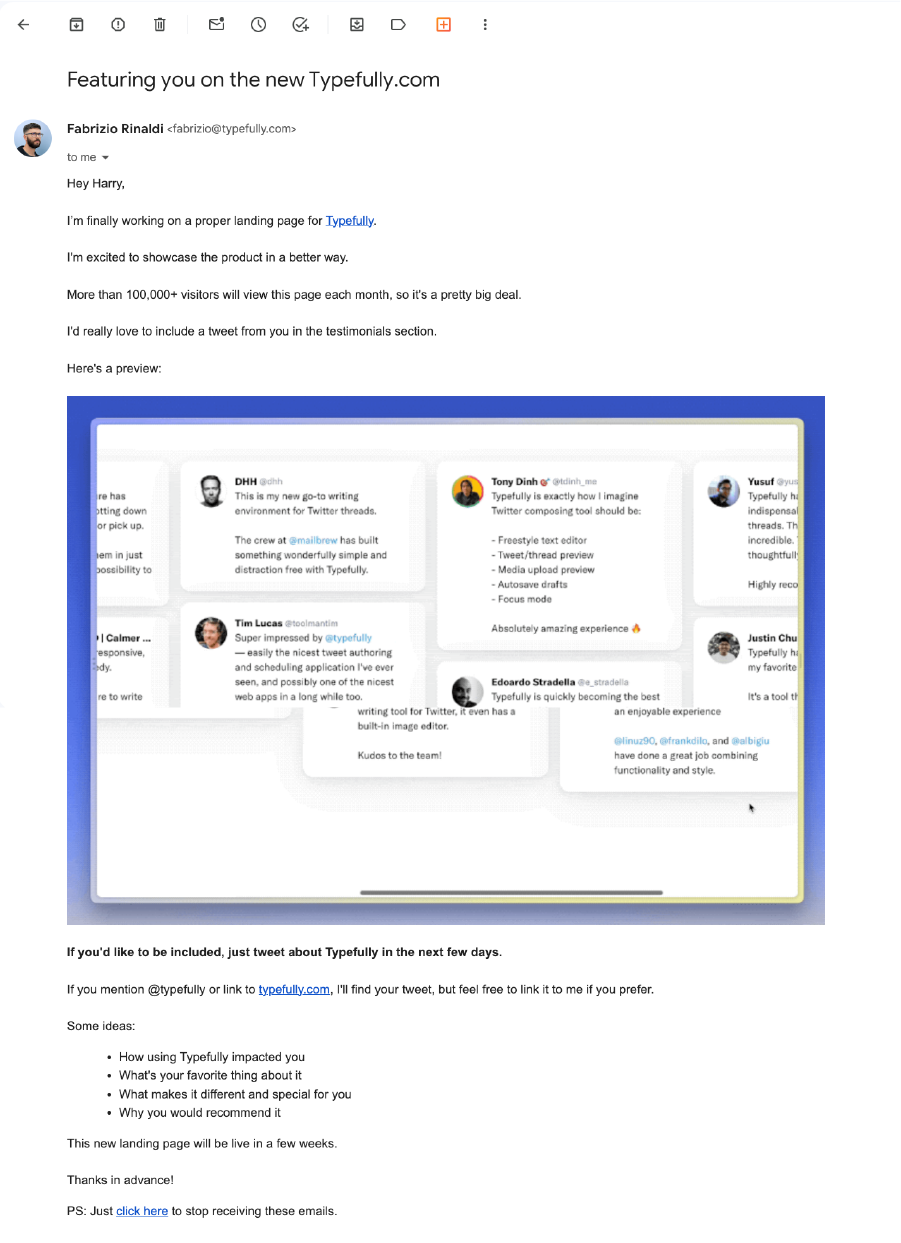
Typefully’s testimonial request example
In this testimonial request email from Typefully, you’ll notice that instead of making it about them, they position the request as an opportunity to get featured on their new website.
Explaining how 100,000 people visit the website each month and how they want to feature you.
They take the request a step further by…
- Showing you how great you’ll look in the preview.
- Create urgency to do it now by setting a time limit of a few days.
- And think for you by prompting you with ideas of what to write.
The takeaway?
Remember to answer the question ‘What’s in it for me?’ in your feedback request emails.
7. Price and policy update emails
From time to time, the way you do business changes. Whether it be price, terms and conditions, or product updates.
When it comes to telling customers about these changes, the way you communicate can affect the relationship with your customers.
One of the best examples of how to do this well is from Slack.
Slack’s price hike email example
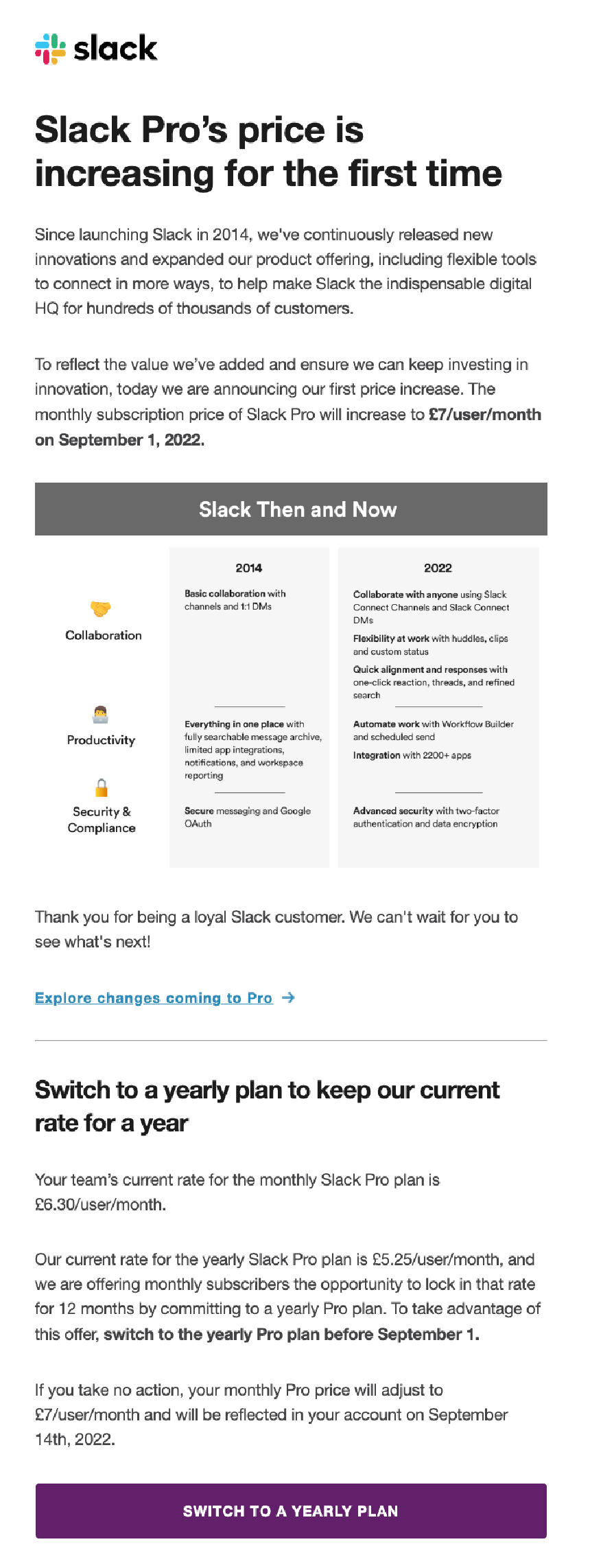
Instead of just saying ‘we’re putting the price up,’ they position this as being long overdue from the headline and reinforce this with the list of features you get with the premium plan today.
What’s also cool about this email is it also presents a persuasive opportunity of why it would be wise to switch to the annual plan to lock in your savings.
So next time you’re putting your price up ask yourself: How can you make your customers feel they’ve been getting a steal all this time?
The takeaway?
The way you position business updates can have a huge impact on your bottom line.
What you should do now?
Hopefully by now you have a good idea about the types of emails you can send. The list above is by no means complete, but it should serve as some solid inspiration. Ultimately what you send, and when depends on your business.
If you’d like to start sending marketing emails from Gmail, you should try Mailmeteor, the leading email marketing platform for Gmail used by 6 million marketers like you globally.
FAQs
Which email type of best?
The type of email that works best depends on your goal and where someone is inside your marketing funnel.
Why do you need different types of emails?
Because bombarding your email list with the same type of email will cause fatigue and not be tailored to each stage of your customer journey.
How many emails are too many?
There isn’t a one-size-fits-all answer for how many emails you should be sending. If people are opening and engaging with your content more, daily emails are not unheard of. Don’t be afraid to email your customers as long as it’s valuable.
